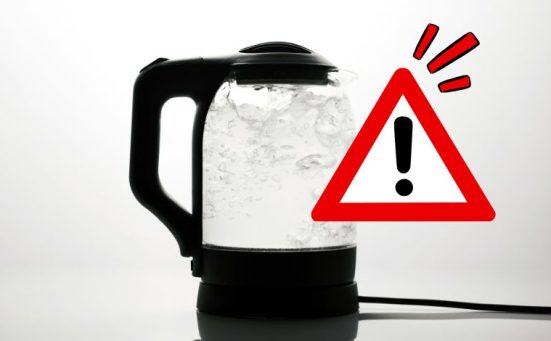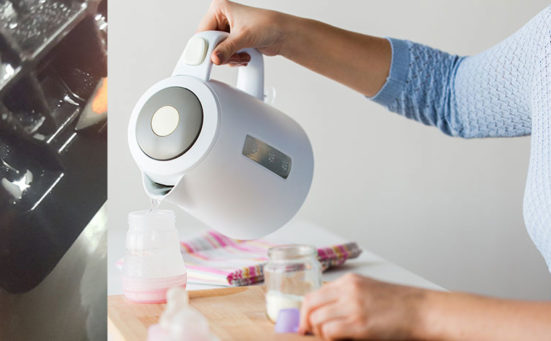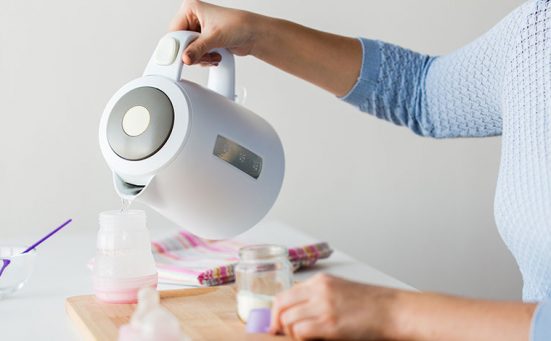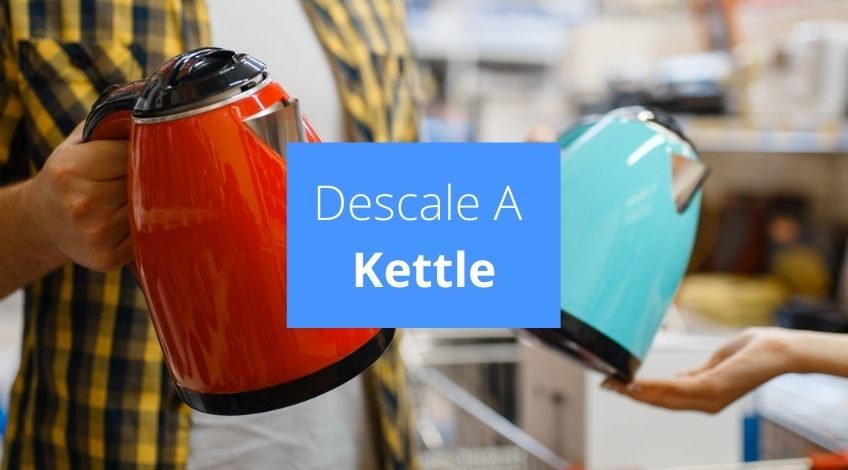
How To Descale A Kettle
Have you been using your kettle for a couple of months? Do you live in the UK? If you answered yes to both of those questions, then chances are your kettle will have scale. Most of the UK is classified as a hard water area, and hard water is what’s responsible for causing scale in the kettle.
It’s important to keep the kettle scale-free, to keep the kettle working efficiently and to prevent your hot drinks tasting off. Not to mention those horrible limescale particles that touch your lips or enter your mouth when you’re drinking a cup of tea.
What Causes Scale In Kettles?
As we said earlier, it’s hard water that causes the scale in the kettle. It’s a geological thing, as the soft rainwater passes through the porous rock it picks up deposits from the rocks. These water-soluble deposits eventually find their way into our tap water and from there into our kettles.
Then it’s a chemistry thing, as the kettle heats the water it changes the chemical composition of the water. Once it reaches boiling point some of it turns to steam and any deposits in the water like limescale, cling onto the metal element or kettle base, and fur up the kettle. So now we know what causes it and how it forms, let’s look at how to descale the kettle.
5 Ways To Descale Your Kettle
We’ve found 5 ways to descale your kettle, giving you a choice on how to get rid of that nasty limescale build-up in your kettle. We’ll start with a chemical solution and then go on to all-natural remedies.
How To Descale A Kettle With A Chemical Descaler
This is such a simple solution you just
- Fill your kettle to the halfway mark.
Half fill the kettle with tap water. - Allow the kettle to boil.
Once the water has boiled, carefully remove the lid. - Add one sachet of chemical kettle descaler.
Pour the contents of the sachet into the kettle. - Leave for 10 minutes.
Allow the solution to soak into the scale for at least 10 minutes – Longer is better, and overnight is better still. - Pour solution away.
Pour the solution down the sink, you should notice a marked reduction in limescale. - Rinse and refill the kettle.
Rinse all remaining traces of the solution out of the kettle, then refill with tap water. - Boil, rinse and boil again to remove all traces of the chemical.
Repeat the rinsing and boiling process at least 3 times or until all chemical traces are removed. - The kettle is ready to use again.
Repeat the entire process every 4 to 6 weeks.
How To Descale A Kettle With Vinegar
Because the limescale dissolves in a mild acid, vinegar is the perfect, safe acid for descaling the kettle. Just:
- Fill the kettle with a 50/50 solution of white vinegar and water.
Boil and leave to sit for at least 1 hour. - Pour the liquid away
Using a damp cloth or a long-handled brush clear away any limescale deposits that are left. (They should be soft enough to remove without force). If there are any tough bits remaining pour some baking powder onto the cloth and rub the limescale away. - Refill and boil the kettle with fresh tap water
Continue refilling and boiling until all traces of the vinegar smell are gone. - The kettle is usable once more.
To ensure that the kettle doesn’t build up with limescale again, repeat every month or so.
How To Remove Limescale From A Kettle Using Lemon Juice
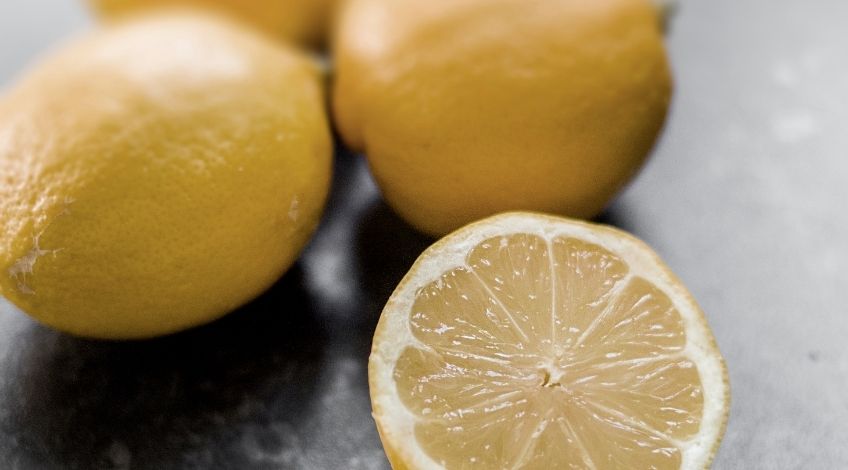
If you don’t have any white vinegar handy, or you don’t like the idea of using vinegar in the kettle, lemon juice will work instead. To remove scale from the kettle using the juice from a lemon just:
- Mix 1 ounce (30 ml) of lemon juice with 18 ounces (500 ml) of tap water.
Freshly squeezed lemon juice is best but bottled lemon juice works perfectly fine as long as it’s pure lemon juice. - Leave the mixture in the kettle for about an hour.
Without boiling the kettle first, let the lemon juice and water soak into the hard limescale deposits. - Boil the kettle
After the hour has passed, boil the kettle containing the mixture. - Pour the contents of the kettle away
Once boiled pour the liquid away and rinse the kettle. - Refill the kettle with tap water.
Boil the kettle to remove any lemon smell from the kettle (this might take 2 or 3 refills and boils). - The kettle is ready for use once again.
To maintain a scale-free kettle this process should be repeated monthly.
How To Descale A Kettle Using Cola
Yep! You read it correctly, cola. All you need to do is:
- Pour ½ litre of cola into the kettle
Be sure the kettle was empty before pouring in the cola. - Allow to work for at least 30 minutes
Do not boil the kettle, just allow the cola to soak into the limescale. Boiling the kettle will evaporate some of the sugar from the cola, which will coat the inner walls of the kettle and be extremely difficult to remove. - Without boiling the kettle, pour the contents away
After the 30 minute period is up, pour away the cola and rinse the kettle a couple of times with fresh water. - The kettle is usable again
This process should be carried out every month to eliminate limescale build-up.
Using Pickle-Water To Descale A Kettle
When all the pickles have been eaten, the water left in the jar (which is mainly vinegar and salt) makes a great kettle descaler. Just:
- Fill the kettle with pickle-water
Fill the kettle with a solution of water and pickle-water in a 50/50 mixture ( 100% pickle-water is better but not always possible). - Boil the kettle
Allow the kettle containing the pickle-water solution to boil and cool. - Pour away the contents of the kettle
Once cooled, pour the contents away and refill the kettle with tap water. - Boil with fresh water
Using fresh tap water, boil the kettle full of water, rinse and repeat until all pickle smell is gone. - Reuse the kettle.
This can be repeated on a monthly basis to keep scale from building up in your kettle.
How To Prevent Kettle Limescale Build-Up In The Future
There are a few ways to prevent limescale build-up that doesn’t cost a fortune to implement, we advise you to.
- Use kettle protector
These are little balls of stainless steel mesh, that prevent limescale from building up in the kettle. The limescale is attracted to the mesh and can be used in stove-top or electric kettles. They really are an inexpensive option, costing around £1 each. Once they are full of scale they can be cleaned by soaking them in one of the remedies above, or just discarded and replaced. - Don’t overfill the kettle
Most modern kettles have a measure on the side that shows you how many cups of water you are boiling, use it to only boil as much water as you need. Always leave the kettle empty after use, this helps to prevent the build-up of limescale. - Descale Regularly
If you descale your kettle every month, the scale will not build up to a great extent. This will make descaling much easier to achieve.
Frequently Asked Questions
You can use malt vinegar to descale a kettle but as it is stronger smelling, and darker than white vinegar, it will take more rinsing to remove any traces of malt vinegar.
Limescale is not particularly bad for you, but allowing limescale to build-up in your kettle will cost you more money on electricity.
The difference between white vinegar and malt vinegar is the way it is made. White vinegar is purified vinegar, it only contains 2 ingredients, water and acid. Malt vinegar is made from malting barley. Malt vinegar is also milder and tastes sweeter than white vinegar.
Leaving water in a kettle does cause limescale to build-up faster than if the kettle was left empty.
You should descale your kettle every month if you live in a hard water area, and every 3 months if you live in a soft water area.
To get rid of limescale on the outside of a kettle just wipe with a cloth soaked in white vinegar or lemon juice and rinse off with a clean damp cloth.
You should not reboil water because any chemicals in the water get concentrated.
You can leave vinegar in a kettle overnight, just be sure to rinse the kettle thoroughly before use to remove any traces of vinegar.
Coke does descale a kettle but never boil the kettle with coke inside. The sugars from the coke will evaporate and stick on the inside of the kettle.
Limescale does affect the energy-efficiency of a kettle. Because limescale prevents direct contact between the heating element and the water. Which means the kettle will take longer to reach boiling point leading to more power usage. To view our list of the best energy-efficient kettles click here.
Also, follow us on Pinterest ...

